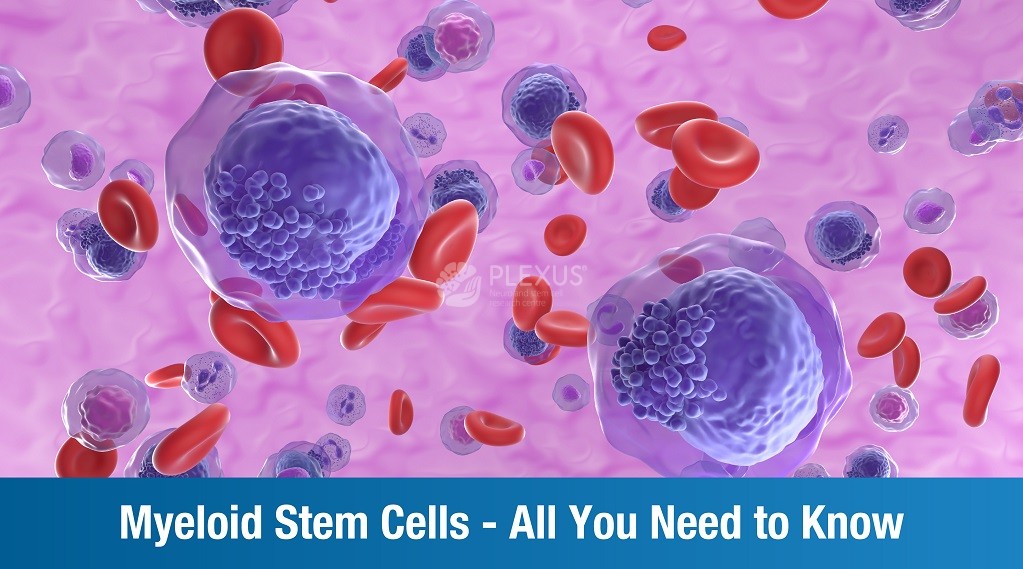
Let’s understand myeloid stem cells, their development and differentiation, the various types, and how they can be used in the stem cell therapy to greatly improve the condition of people with neurological diseases.
What are myeloid stem cells?
A type of blood cell that originates in the bone marrow, myeloid stem cells mature into adult blood cells that have specific roles. This family of blood cells include –
- Platelets – also called thrombocytes, these are small colorless fragments (of cells) found in our blood; their main function is to firm clots to prevent/stop bleeding
- Erythrocytes – hemoglobin containing red blood cells, they carry oxygen from the lungs to other parts of the body
- Macrophages – white blood cells in the immune system, fights and destroys bacteria; also get rid of cells that are worn out or in need of replacing
- Monocytes – white blood cells in the immune system, destroys viruses, bacteria, and fungi
- Granulocytes – white blood cells with with small proteins in their cytoplasm
- Basophils – found immune system, they form the frontline defense against disease, and also help manage/reduce inflammation and allergy
- Neutrophils – found in blood, tissues, and lymph nodes; first barrier of protection you contract bacterial infection
- Eosinophils – fight disease and infection
What are lymphoid stem cells?
Our bodies produce both lymphoid stem cells and myeloid stem cells. Their origins can be traced back to the multipotent hematopoietic stem cells which divide to make progenitor cells (replacement cells).
Each progenitor forms its own family of blood cells.
(ref above section for myeloid family of blood cells)
Lymphoid family of blood cells include –
- B Lymphocytes or B Cells – produces antibodies and protects our body from infection
- T Lymphocytes of T Cells – found in the immune system, they protect our body from bacteria, virus, and cancer cells
- Natural killer cells – found in the immune system, these cells eliminate cancer cells and virus cells
Difference between myeloid and lymphoid stem cells
The myeloid lineage of stem cells matures in the bone marrow environment. Whereas the lymphoid lineage of stem cells mature outside the bone marrow.
Development and differentiation of myeloid stem cells
Myelopoiesis is the development of myeloid stem cells from multipotent hematopoietic stem cells. Myeloid cells originate in the red bone marrow and make sure the body’s blood cell types are continuously replenished.
Myeloid stem cell differentiation is the process by which a myeloid stem cell matures into a more specialized cell. Prior to differentiation the cell may be unspecialized or partially specialized.
Stem cell transplantation
At India’s no. 1 stem cell centre
At Plexus Neuro and Stem Cell Research Centre we believe every life is worth not just fighting for, but living for too! And that is why we offer the best stem cell transplantation in India for chronic degenerative neurological disorders.
We use autologous stem cells taken from the patient’s own body. The procedure is conducted by India’s no. 1 stem cell specialist, Dr. Na’eem Sadiq.
To book an appointment, please call us on:
+91 89048 42087 | 8229999888
FAQs
Is bone marrow a myeloid?
Bone marrow is the soft, fatty tissue present in our bones. Myeloid is a type of tissue found in the bone marrow. Myeloid stem cells are blood cells that originate in the bone marrow.
Are platelets myeloid cells?
Yes, platelets are a part of the myeloid lineage, or myeloid family of cells.
Are myeloid cells immune cells?
Yes, myeloid cells play a crucial role in maintaining our immune system.
What is the function of myeloid cells?
Myeloid cells form all types of blood cells (except lymphocytes) and protect the body from virus, bacteria, and all other types of infection.










